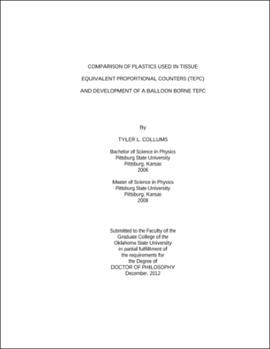| dc.contributor.advisor | Benton, Eric R. | |
| dc.contributor.author | Collums, Tyler Lance | |
| dc.date.accessioned | 2013-11-26T08:26:29Z | |
| dc.date.available | 2013-11-26T08:26:29Z | |
| dc.date.issued | 2012-12 | |
| dc.identifier.uri | https://hdl.handle.net/11244/6879 | |
| dc.description.abstract | This study investigates alternatives to A-150 tissue equivalent plastic for use in the construction of tissue equivalent gas-filled detectors for the measurement of dosimetric quantities. This study looks at four different alternative plastics: acrylic, Nylon, polyethylene, and polystyrene. These alternative materials are more readily available and easier to machine than A-150 tissue equivalent plastic. In this study they are compared to A-150 tissue equivalent plastic to determine how they compare in the measurement of lineal energy spectra from energetic protons and heavy ions as found in the space radiation environment, as well as at relevant clinical energies used in proton and heavy ion therapy. In experiments carried out at the ProCure proton therapy center in Oklahoma City, five proportional counters possessing ionization cavities constructed of five different materials (A-150 tissue equivalent plastic, acrylic, Nylon, polyethylene, and polystyrene) were used to measure the lineal energy spectra of energetic proton beams of 87 MeV, 162 MeV, and 222 MeV. Exposures to energetic heavy ions were carried out at HIMAC in Japan using beams of 143 MeV/amu He, 265 MeV/amu C, 440 MeV/amu Si, 430 MeV/amu Ar, and 421 MeV/amu Fe. Monte Carlo simulations using FLUKA were also done for each detector for each proton beam and each heavy ion beam. Comparison of the measured data obtained at ProCure and HIMAC, as well as simulation results using the Monte Carlo code FLUKA, indicate that the responses of the four alternative plastics tested are very similar to the response of A-150 tissue equivalent plastic. FLUKA simulations done for a detector made of ICRU muscle are also shown to have a response similar to that of all five plastics. A flight version of the TEPCs has also been developed for a high altitude flight on a balloon or other vehicle. | |
| dc.format | application/pdf | |
| dc.language | en_US | |
| dc.rights | Copyright is held by the author who has granted the Oklahoma State University Library the non-exclusive right to share this material in its institutional repository. Contact Digital Library Services at lib-dls@okstate.edu or 405-744-9161 for the permission policy on the use, reproduction or distribution of this material. | |
| dc.title | Comparison of plastics used in tissue equivalent proportional counters (TEPC) and development of a balloon borne TEPC | |
| dc.contributor.committeeMember | Yukihara, Eduardo G. | |
| dc.contributor.committeeMember | Peakheart, David W. | |
| dc.contributor.committeeMember | Arena, Andrew S. | |
| osu.filename | Collums_okstate_0664D_12417 | |
| osu.accesstype | Open Access | |
| dc.type.genre | Dissertation | |
| dc.type.material | Text | |
| dc.subject.keywords | a-150 | |
| dc.subject.keywords | ionizing radiation | |
| dc.subject.keywords | lineal energy | |
| dc.subject.keywords | proportional counter | |
| dc.subject.keywords | tissue equivalent | |
| thesis.degree.discipline | Physics | |
| thesis.degree.grantor | Oklahoma State University | |
